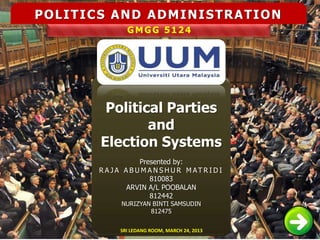Political parties and election systems
- 1. POLITICS AND ADMINISTRATION GMGG 5124 Political Parties and Election Systems Presented by: R A JA A B U M A N S H U R M AT R I D I 810083 ARVIN A/L POOBALAN 812442 NURIZYAN BINTI SAMSUDIN 812475 SRI LEDANG ROOM, MARCH 24, 2013
- 2. Outlines Political Parties and Electoral Systems 1 Political Parties 2 Party Functions 3 Type of Political Parties 4 Electoral Systems 5 Categories of Electoral Systems 6 Example in Southeast Asia Countries SRI LEDANG, MARCH 24, 2013
- 4. Party Functions Organizing the election Facilitating voter choice Recruiting candidates Michael P. Fix, 2009. Screening candidates Organizing a complex government Aggregating interest Educating citizens Ensuring accountability Promoting civic performance
- 5. Type of Political Parties The One Party or No Party Systems ŌĆó A party system in which one political party controls the government and voters have no option to choose an opposition party. One-Party Dominant Systems ŌĆó A party system in which one large party direct the political system, but small parties exist and may compete in election. The Two-Party Systems ŌĆó A party system in which two main parties compete for majority control of the government; small parties exist but play no role in national electoral outcomes Two and a half party systems ŌĆó A party system in which to large parties exist alongside a third party that recieves a smaller but notable share of the national vote Multi-Party Systems ŌĆó A party system with several important political parties, none of which generally gains majority of the seats in the national legislature. All Party Systems ŌĆó A party system in which every party will get a power-sharing based on the achievement of results. Emerson,2012. Barrington.,2013.
- 6. Electoral system ŌĆó The set of rules that structure how votes are cast at elections for a representative assembly and how these votes are then converted into seats in that assembly ŌĆó E.g. Ease of access to the ballot for would-be candidates, the right vote, the fairness of the administration of the election, the transparency of the counting of the votes. Michael Gallagher & Paul Mitchell, 2008
- 7. Categories of Electoral system Broad Category Specific Types Single-Member Single-Member Plurality (SMP) Constituency System Alternative vote (AV) Two-Round system (2SR) Mixed System Mixed Compensatory Mixed paralel Closed-List System - Preferential List System Open List Flexible List PR-STV - Michael Gallagher & Paul Mitchell, 2008
- 8. EXAMPLE MALAYSIA SINGAPORE Consortium for Elections and Political Process Consortium for Elections and Political Process Strengthening (CEPPS) 2012. Strengthening (CEPPS),2011. The Sultan is elected by The President is elected by hereditary state rulers plurality vote The Prime Minister is appointed by The Prime Minister is the President designated by parliament The Parliament: ’üČ 9 members are elected by The Senate: plurality vote ’üČ 44 members are appointed ’üČ75 members are elected through by the monarch a group representation constituency The House of Representatives: ’üČ 9 members are nominated by ’üČ 222 members are elected by the President plurality vote ’üČ 9 members are appointed from a national compensatory list
- 9. CONTINUE INDONESIA THAILAND Consortium for Elections and Political Process Consortium for Elections and Political Process Strengthening (CEPPS), 2010. Strengthening (CEPPS), 2011 The President is elected by The King is the hereditary head of absolute majority state The Prime Minister is appointed by The Regional Representative the monarch Council: The Senate: 132 members are elected by ’üČ74 members are appointed and single non transferable vote 76 members are elected by single non-transferable vote. The House of Representatives: The House of Representatives: 560 members are elected by ’üČ375 members are elected by open list proportional plurality vote representation ’üČ125 members are elected through a closed-list proportional representation
- 10. COGNITIVE T Y PP R O A F H AP E O C ELECTION SYSTEM PLURALITY MALAYSIA VOTING PLURALITY SINGAPORE VOTING PROPOTIONAL INDONESIA VOTING (OPEN-List) PROPOTIONAL THAILAND VOTING (CLOSED-list)
- 11. POLITICAL AND ADMINISTRATION (GMGG 5124): POLITICAL PARTIES AND ELECTION SYSTEM Thank you











